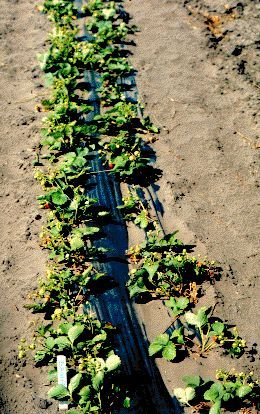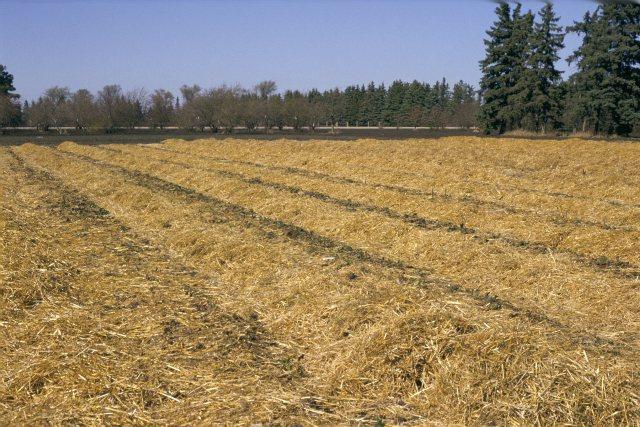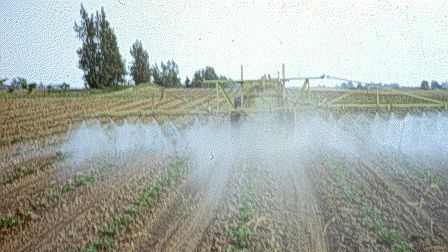Strawberry
Management of Runners
The special care given to establishment of runners will dramatically increase yield potential in the bearing year.
Primary runners that are hand-set early will out-yield secondary and tertiary runners 14 to 1. Quaternary runners usually do not root deep enough to develop significantly by the end of the season.

Once the row is full, the extra runners may be cut off. Use a rolling coulter attached to the cultivator to facilitate their removal. The plantation needs frequent irrigation at runnering time. If soil is moist, runners will develop enough root and top growth by the end of the season to survive the winter. No renovation is required in a first year planting. Renovate after the first full picking season and each subsequent picking year.
Irrigation of a Young Planting
For rapid plant development, maintain a uniform moisture level in the soil at planting time and during the initial establishment period. Do not saturate soil with moisture and keep in mind the potential for rainfall. During runnering, soil moisture at a depth of 0.4 to 0.5 in. (1 to 1.3 cm) should be at least 74% of field capacity to facilitate rapid daughter rooting.
Mulching with straw, or plastic and straw, is necessary to protect the crop from low temperature injury to crowns and roots. When properly applied, mulch keeps soil temperatures more uniform, prevents plants from drying out from cold and dry winds, and helps trap snow. Mulch is usually applied in the late fall after several frosts but before temperature drops to -6.70 C. Timing varies with prairie location but mulch is usually applied between late October and early November. Avoid heavy applications. High slug populations have been associated with over-mulching.

Mulch may blow off sites that are not properly sheltered, particularly if a combination of straw and plastic mulch is used. A slight wetting through irrigation will help keep the mulch in place. On a calm day, apply fresh, dry straw. This material will lie loose and fluffy and provide a good insulation layer. Straw should be sticking up to trap the snow, rather than lying flat.
Wheat or oat straw is the best mulch material for the Prairies. Use straw from grain fields that are as weed-free as possible. From 2 to 3 tons/acre or 120 small bales (4.6 to 6.7 t/ha) are required. The mulch layer should be 2 to 3 in. (5 to 8 cm) thick after settling. Applying a thicker layer of straw does not provide a proportional increase in insulation. Trapped air spaces in the straw layer provide the insulation for good winter protection. The straw spreader should apply an even cover over the entire area and should not chop the straw into short lengths.
A straw spreader-applicator called the "Bale Buster" can apply straw directly to several rows at a time, from large round bales. The only labour required by this system is one person to drive the tractor and load the machine with the large bale. Many growers have reduced the investment in a straw spreader by building their own machine.

A herbicide should be applied just before mulching to provide weed and volunteer grain control in the spring. For specific recommendations, consult your local chemical weed control bulletins. Delayed mulch removal in the spring can set blooming back several days. This adversely affects yield and the future survival potential of plants. With a plastic and straw mulch, delayed removal is even riskier.
Moving the straw mulch between the rows in the spring helps keep berries clean, conserves moistures, suppresses weeds and provides a pleasant picking area.
Plastic Mulching
With certain cultivars and in low snow cover conditions, winter survival may be improved by applying a 1.5 mm layer of clear plastic film before plants are covered with the straw. The plastic can be applied several weeks before straw is spread in late October. In early April, the plastic must be removed or "slit" to prevent plant damage caused by increased temperatures under the plastic.
This technique has improved winter survival and normally advances harvesting by seven to ten days. However, early spring plant development may require more frost control measures. Also, straw is more likely to blow off windy sites if plastic mulch is used.
Growers should experiment with the technique before adopting the practice on a full scale.
Mulch Removal
Remove mulch in the spring as new growth begins and new leaves become a light yellow colour. This normally will occur between mid April and early May for most prairie locations. It is especially important to remove plastic mulch, which should be taken off at least two weeks prior to straw mulch. Remove mulch earlier if the soil is wet.
Remove excess straw from the rows and aisles with a side delivery rake.
Rotary mowers are also an excellent way of removing straw. The rotating blades place the straw into the aisles. Two passes over the rows will do a complete job.
A beet top flailer is another machine used for straw removal. Fairly accurate adjustments can be made to the topper to allow partial removal of the straw.
Partial mulch removal delays development without harming plant growth. This practice can be used to delay bloom development and avert early frost damage to mature blooms.
Spray Program for the Picking Year
Insecticides or fungicides should only be applied when insect populations and disease infections reach levels that would adversely affect profits. Eradication of all pests is not the goal of pest control.
Growers should become familiar with the life cycles of strawberry pests, know how to detect their presence and inspect fields periodically. For example, many pests overwinter in leaf litter in the row and start their activity even before straw removal. Plants suffering winter injury or stress appear to be more prone to injury by insects and disease, and therefore require careful monitoring.
The tarnished plant bug, strawberry weevil or strawberry slipper can cause serious yield reduction by damaging the fruit. For more information, see the section on Disease and Insect Control.
Spring Fertilizer Applications
Apply 10 lb/acre (11 kg/ha) of nitrogen to bearing fields after flower buds have started to form. Excessive nitrogen levels result in overly vigorous leaf canopies that interfere with pollination and fruit quality. For more information, see the section on Fertilizers.
Lack of proper pollination is one of the major causes of deformed berries.
Deformed berries are caused by:
- slight frost injury to blossoms
- injury from tarnished plant bugs
- lack of proper pollination.
Strawberries are self pollinated.
Pollination occurs by the action of wind shaking the flower stem, or through native insects and honey bees. The latter is particularly true when bee colonies are located in the fields. One colony per acre (two per ha) are recommended. Insecticide sprays are toxic to bees. They should be applied late in the evening when the bees are less active and only when harmful insect populations exist.

